Spotlight on Fort Myers’ Ward 4 art hub at Edison Ford Winter Estates
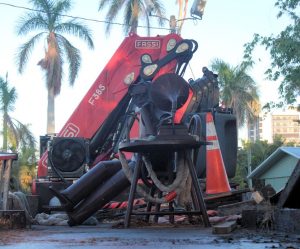 The Fort Myers Public Art Committee is establishing art hubs in each of the City’s six wards using the 23 Edgardo Carmona sculptures that the City purchased in August of 2018. One such art hub is the Edison & Ford Winter Estates. On December 6 (2022), the Committee relocated Music Lover (Melomano) to the courtyard between the museum and the Edison Botanical Laboratory.
The Fort Myers Public Art Committee is establishing art hubs in each of the City’s six wards using the 23 Edgardo Carmona sculptures that the City purchased in August of 2018. One such art hub is the Edison & Ford Winter Estates. On December 6 (2022), the Committee relocated Music Lover (Melomano) to the courtyard between the museum and the Edison Botanical Laboratory.
The term art 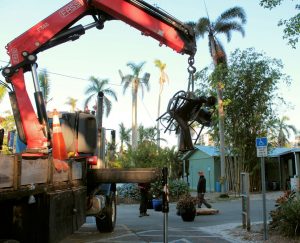 hub refers to a location that is already or which is intended to become either a cultural, business or residential destination. The Edison & Ford Winter Estates clearly falls into the former category.
hub refers to a location that is already or which is intended to become either a cultural, business or residential destination. The Edison & Ford Winter Estates clearly falls into the former category.
The Edison & Ford Winter Estates is home to the winter residence of Thomas Edison (called Seminole Lodge), the craftsman-style bungalow of Henry Ford (The Mangoes), the Edison Ford Museum, associated gift 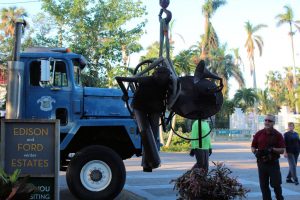 shop and Edison’s Botanic Research Laboratory. All five are situated on a 21-acre botanical garden on the Caloosahatchee River that is governed by a nonprofit whose mission is to protect and preserve the side, educate the public and inspire an inventive spirit by interpreting and promoting the innovations, legacies, artifacts, gardens, homes, laboratory, and other structures of Thomas Edison and Henry Ford,
shop and Edison’s Botanic Research Laboratory. All five are situated on a 21-acre botanical garden on the Caloosahatchee River that is governed by a nonprofit whose mission is to protect and preserve the side, educate the public and inspire an inventive spirit by interpreting and promoting the innovations, legacies, artifacts, gardens, homes, laboratory, and other structures of Thomas Edison and Henry Ford,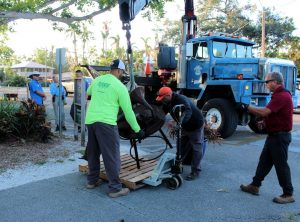 emphasizing Florida history, science, horticulture and the arts.
emphasizing Florida history, science, horticulture and the arts.
Music Lover of Melomano depicts a man in a rocking chair listening to music on an old phonograph. Columbian sculptor Edgardo Carmona did not intend the piece as a tribute to Thomas Edison, but rather as a study of the elements of setting, position and mystery. 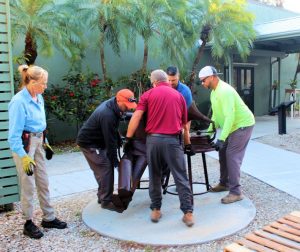 Everything about the man, from the way he leans forward in his chair to how he brings his ear close to the speaker, conveys excitement, curiosity and a sense of mystery and magic.
Everything about the man, from the way he leans forward in his chair to how he brings his ear close to the speaker, conveys excitement, curiosity and a sense of mystery and magic.
While today, we take the technology for playing live and recorded music for granted, that wasn’t the case when Thomas Edison invented and introduced the first photograph to the public in 1878. People were blown away. While Edison initially saw 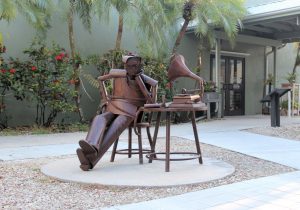 his device as a way to dictate business letters, preserve the voices of political and other leaders for posterity and as a means to share books with the visually impaired, the public quickly honed in on his invention’s ability to record and play music at home. Edison picked up on the idea and within a decade formed the world’s very first record company, which competed successfully in an expanding market into the 1920s.
his device as a way to dictate business letters, preserve the voices of political and other leaders for posterity and as a means to share books with the visually impaired, the public quickly honed in on his invention’s ability to record and play music at home. Edison picked up on the idea and within a decade formed the world’s very first record company, which competed successfully in an expanding market into the 1920s.
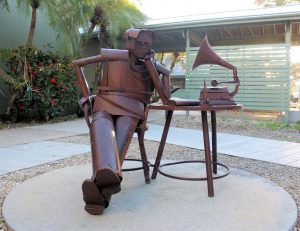 While the phonograph depicted in Melomano may or may not be an Edison phonograph, people exiting the Edison Ford Museum will definitely be reminded of the three tin-foil phonographs on display inside.
While the phonograph depicted in Melomano may or may not be an Edison phonograph, people exiting the Edison Ford Museum will definitely be reminded of the three tin-foil phonographs on display inside.
“The tin-foil phonographs we have in our collection are some of the earliest examples of Edison’s work dealing with phonographs and sound recording,” 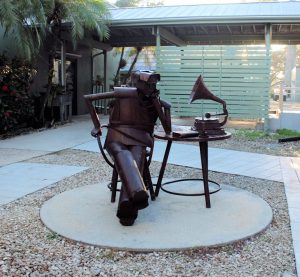 notes Edison Ford Registrar Matt Andres. “They are unique and remarkable pieces from a historical standpoint; I definitely encourage visitors to visit the museum for a closer look.”
notes Edison Ford Registrar Matt Andres. “They are unique and remarkable pieces from a historical standpoint; I definitely encourage visitors to visit the museum for a closer look.”
The River District is home to a number of other art hubs, ranging from Centennial Park East (which is home to Uncommon Friends, the USCT 2nd Regiment Monument, the Buckingham & Page Army Air Field Monument and The Florida Panther) 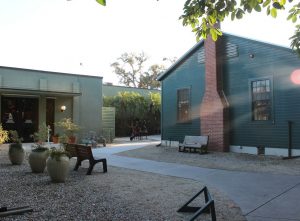 and Centennial Park West (Fire Dance) to The Collaboratory (Ribbon Routine), Florida Repertory Theatre (Unicycle Juggler), Edison Park Entrance (The Spirit of Fort Myers), Fort Myers Country Club (Tootie McGregor Fountain), Fort Myers-Lee County Garden Council (Lorelei), Fort Myers Regional Library (Stacked Brands), Franklin Shops on First (Two Drunks on a Bench), Greater Fort Myers Chamber of Commerce
and Centennial Park West (Fire Dance) to The Collaboratory (Ribbon Routine), Florida Repertory Theatre (Unicycle Juggler), Edison Park Entrance (The Spirit of Fort Myers), Fort Myers Country Club (Tootie McGregor Fountain), Fort Myers-Lee County Garden Council (Lorelei), Fort Myers Regional Library (Stacked Brands), Franklin Shops on First (Two Drunks on a Bench), Greater Fort Myers Chamber of Commerce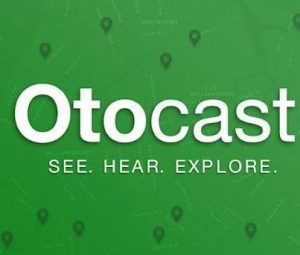 (Don Quixote), Langford Kingston Home (busts of Chief Billy Bowlegs, Captain Francis Asbury Hendry, Tootie McGregor Terry, James D. Newton and Connie Mack), the Laboratory Theater of Florida (Fertilization), Park of Palms (82nd Airborne Monument), Sidney & Berne Davis Art Center (Caloosahatchee Manuscripts) and Scoops on First (Snow Cone Vendor).
(Don Quixote), Langford Kingston Home (busts of Chief Billy Bowlegs, Captain Francis Asbury Hendry, Tootie McGregor Terry, James D. Newton and Connie Mack), the Laboratory Theater of Florida (Fertilization), Park of Palms (82nd Airborne Monument), Sidney & Berne Davis Art Center (Caloosahatchee Manuscripts) and Scoops on First (Snow Cone Vendor).
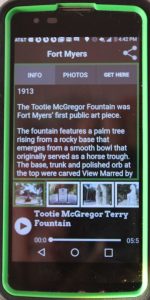 To encourage the public’s enjoyment of and interaction with the artworks located in each of the City’s art hubs, the City’s Public Art Committee has subscribed to a free mobile app called Otocast. The app includes text, photographs and audios that provide information and tell behind-the-scenes stories about all of the City’s public artworks and the artists who created them. The Committee expects to go live with text, photographs and an audio for Music Lover within the next few weeks.
To encourage the public’s enjoyment of and interaction with the artworks located in each of the City’s art hubs, the City’s Public Art Committee has subscribed to a free mobile app called Otocast. The app includes text, photographs and audios that provide information and tell behind-the-scenes stories about all of the City’s public artworks and the artists who created them. The Committee expects to go live with text, photographs and an audio for Music Lover within the next few weeks.
For information about other artworks and art hub locations, please read the articles appearing below or download and enjoy Otocast. It’s free!
December 6, 2022.
RELATED 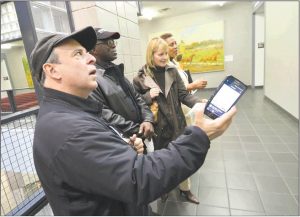 ARTICLES.
ARTICLES.
- Spotlight on Fort Myers’ Ward 1 art hub at Roberto Clemente Park
- Spotlight on Fort Myers’ Ward 1 art hub at Billy Bowlegs Park and Sports Complex
- Spotlight on Fort Myers’ Ward 2 art hub at Urban Community Farm
- Spotlight on Fort Myers’ Ward 3 art hub at IMAG History & Science Center
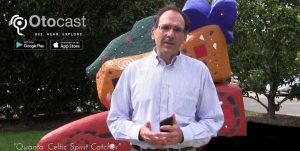 Spotlight on Fort Myers’ Ward 4 art hub at the Collaboratory
Spotlight on Fort Myers’ Ward 4 art hub at the Collaboratory- Spotlight on Fort Myers’ Ward 4 art hub at Florida Repertory Theatre
- Spotlight on Fort Myers’ Ward 4 art hub at The Franklin Shops on First














 Tom Hall is both an amateur artist and aspiring novelist who writes art quest thrillers. He is in the final stages of completing his debut novel titled "Art Detective," a story that fictionalizes the discovery of the fabled billion-dollar Impressionist collection of Parisian art dealer Josse Bernheim-Jeune, thought by many to have perished during World War II when the collection's hiding place, Castle de Rastignac in southern France, was destroyed by the Wehrmacht in reprisal for attacks made by members of the Resistance operating in the area. A former tax attorney, Tom holds a bachelor's degree as well as both a juris doctorate and masters of laws in taxation from the University of Florida. Tom lives in Estero, Florida with his fiancee, Connie, and their four cats.
Tom Hall is both an amateur artist and aspiring novelist who writes art quest thrillers. He is in the final stages of completing his debut novel titled "Art Detective," a story that fictionalizes the discovery of the fabled billion-dollar Impressionist collection of Parisian art dealer Josse Bernheim-Jeune, thought by many to have perished during World War II when the collection's hiding place, Castle de Rastignac in southern France, was destroyed by the Wehrmacht in reprisal for attacks made by members of the Resistance operating in the area. A former tax attorney, Tom holds a bachelor's degree as well as both a juris doctorate and masters of laws in taxation from the University of Florida. Tom lives in Estero, Florida with his fiancee, Connie, and their four cats.